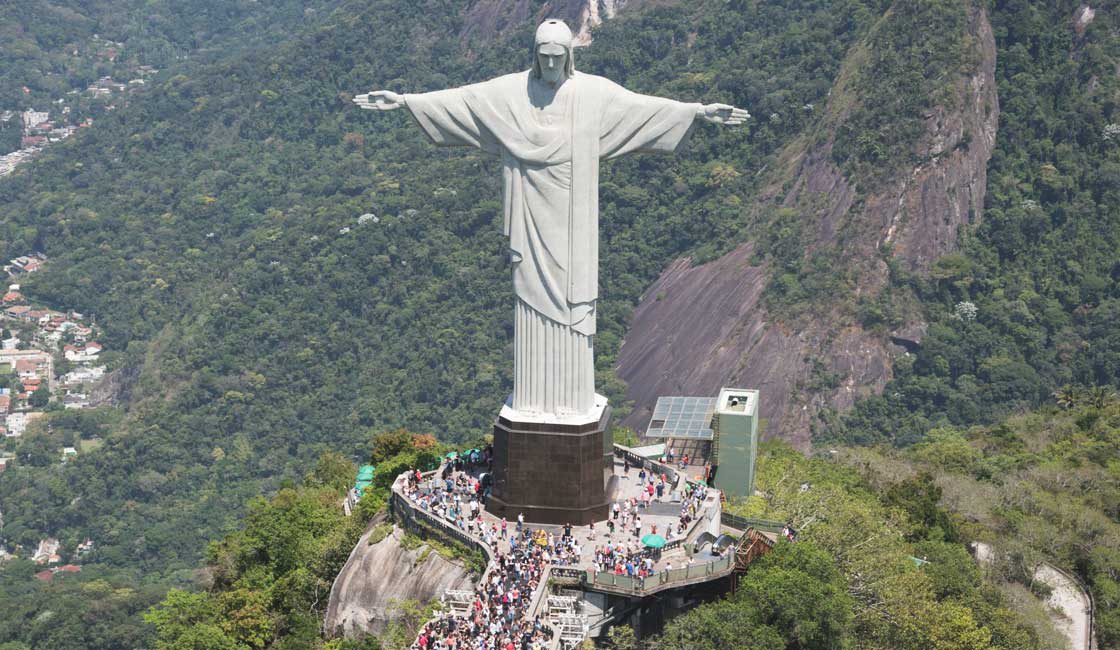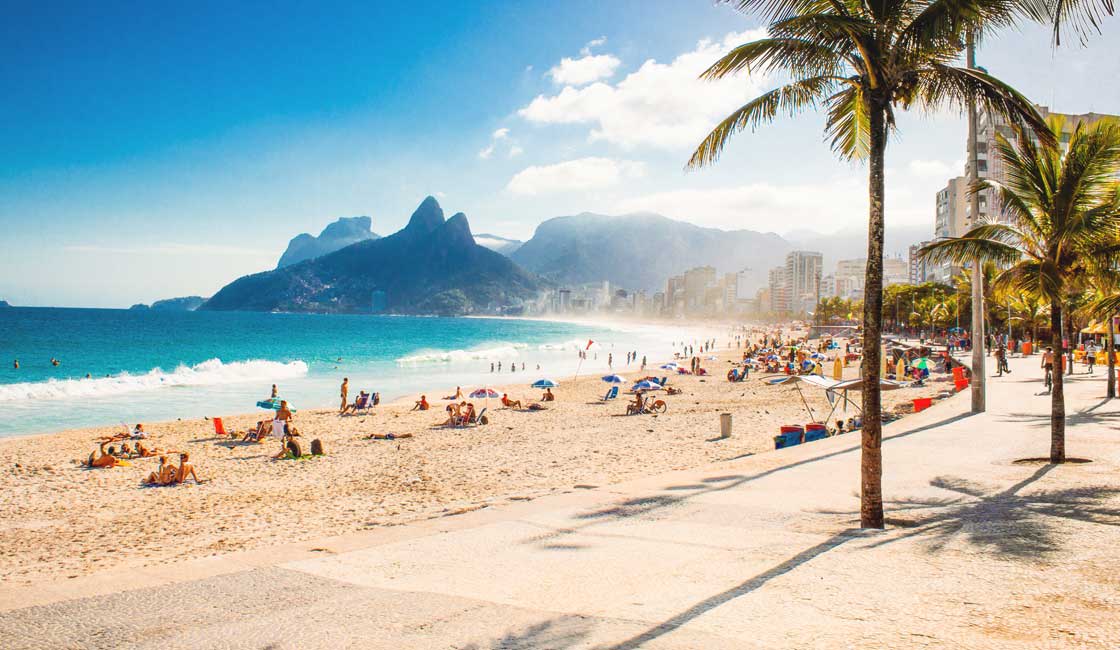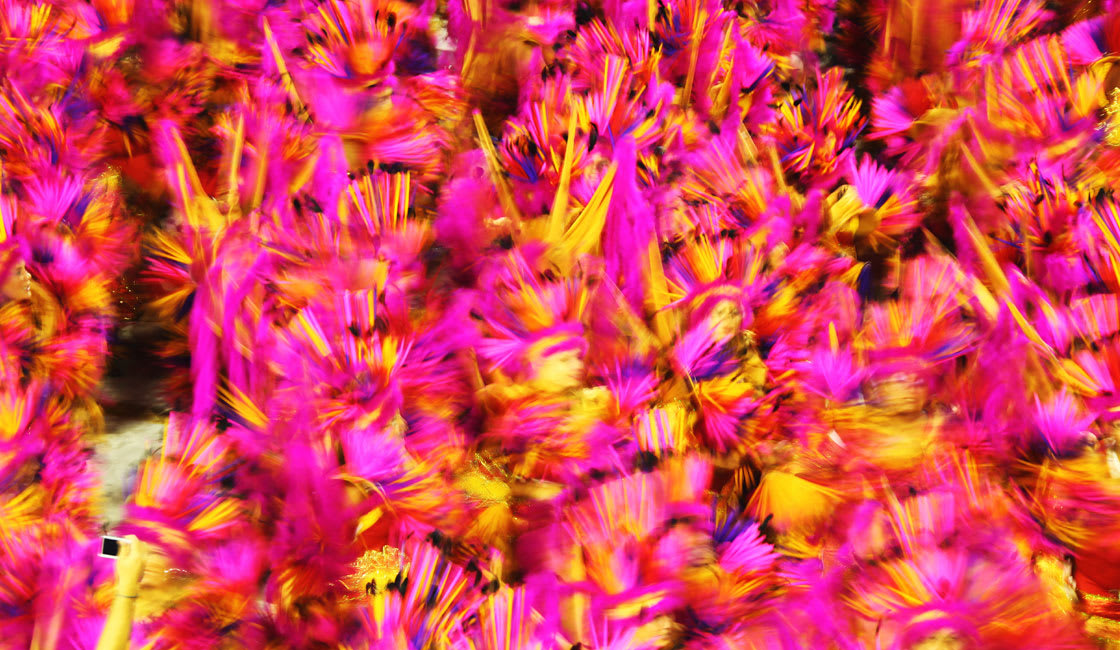
The largest country in South America, Brazil occupies almost half the continent. Nearly all of it is in the Southern Hemisphere, and much of it is tropical, with vast stretches of rainforest filled with exotic plants and wildlife. The country’s 4600-mile-long Atlantic coast is lined with golden-sand beaches, and its interior is filled with mineral resources. Portugal was the colonial power that ruled Brazil until 1822. The national language is Portuguese and a strong Portuguese influence is evident in Brazil’s colonial architecture and decorative arts. Below are what we consider the top attractions worth visiting on a vacation to Brazil.

Cristo Redentor
One of Brazil’s most iconic monuments and Rio’s most visited attraction, the statue of Christ the Redeemer was completed in 1931 and stands 98 feet tall, with horizontally outstretched arms spanning 92 feet. The work of Polish-French sculptor Paul Landowski and Brazilian engineer Heitor da Silva Costa is made of reinforced concrete clad in a mosaic of thousands of triangular soapstone tiles. The statue stands on a square stone pedestal about 26 feet high, which itself is situated on a deck atop the mountain’s summit. The base encloses a chapel that is popular for weddings. The statue has become emblematic of both the city of Rio de Janeiro and the whole nation of Brazil and is the largest Art Deco-style sculpture in the world.
In addition to the symbolic importance within the Catholic community, the statue is also one of the New Seven Wonders of the World and provides spell-binding views over Rio de Janeiro and the bay from the summit of Corcovado, 2310 feet above the city. The area on which it stands is part of the Tijuca National Park, and a rack railway climbs two miles to a broad plaza at the top. A mid-point stop on the railway leads to trails through the Tijuca National Park, replete with springs, waterfalls, and a wide variety of tropical birds, butterflies, and plants.

Way to experience the falls
At the point where Brazil, Paraguay, and Argentina meet, ten miles before joining the Parana River, the Iguaçu River flows over rough, uneven ground, and then, amidst the exuberant forest, spectacularly hurls itself into a semicircular chain of 247 irregular waterfalls that thunder down into the gorge below. Just above the falls, the river is constricted to a quarter of its usual width, making the force of the water even stronger. Some of the falls are more than 330 feet high and they cover such a broad area that you’ll never see all of them at once, but you do get the broadest panorama from the Brazilian side.
A visit to the Iguazu falls is a heart-stopping, visceral experience, while the power and noise of the cascades, which extend nearly 1.85 miles, will live forever in your memory. The falls lie split between Brazil and Argentina in the UNESCO-acclaimed Iguaçu National Park, where subtropical rainforests are home to more than 1,000 species of birds and mammals, including deer, otters, ocelots, and capybaras. Catwalks and a tower offer different perspectives, and one bridge reaches all the way to the largest water curtain, known as the Garganta do Diabo (Devil’s Throat), which drops more than 262 feet into a creamy white pool. You can cross to the Argentinian side for closer views from catwalks that extend farther into the center of the falls. The two sides offer different perspectives and views, so it’s a good idea to plan to see both.

Copacabana

Occupying a narrow strip of land between the mountains and the sea, Copacabana − downtown Rio’s most fashionable district − follows Avenida Nossa Senhora de Copacabana, and is famous for its magnificent two-and-a-half-mile curved beach. Skyscraper hotels, apartment houses, cafés, shops, nightclubs, restaurants, theatres, live music bars, street fairs, and pubs line the waterfront. The neighborhood is a blend of Brazilian soul; it is crowded, rowdy, and traditional. However, the most powerful draw in Copacabana is still the fantastic view of the coast and the incredible white-sand beach alongside the rolling surf.
The beach is separated from the buildings and the traffic by a broad promenade paved in black and white mosaic in a rippled pattern inspired by Rocio’s Square in Lisbon, Portugal. The huge strip of sand bordering Copacabana Beach is not the result of a natural process; during the ’70s, a large land reclamation increased the area of the beach, which is a popular playground filled with sun-worshippers whenever the weather is fine.

Samba!
Rio de Janeiro Carnaval is one of Brazil’s top tourist attractions − the mother, the mecca, the king of all carnivals. Every year, just before the beginning of Lent, Rio de Janeiro transforms into the biggest party on the planet, a party that is attended by five million people from all around the world. Few shows match Carnaval’s extravaganza for color, sound, action, and exuberance. This is not just another boisterous street party, but a carefully staged showpiece. The highlight of attending Rio Carnaval is witnessing the world-renowned Samba Parade hosted in a purpose-built stadium called the Sambódromo, where dancers and musicians from the competing samba schools strut their stuff in a dazzling explosion of brilliant costumes.
Carnaval is an exhilarating time to be in Rio, all the businesses unrelated to Carnaval shut down and the Brazilians completely embrace the carnival spirit, joining street parties across the city. You’ll also find Carnivals in Salvador, Bahia, Recife, and other Brazilian cities.
Bordered by Arpoador Beach on one end and Leblon Beach on the other end, Ipanema Beach is considered one of the main centers of activity for the city of Rio and one of the most expensive places to live. Known as the “Little Paris” of Rio, it is renowned for its avant-garde art galleries, bookstores, movie theaters, hotels, restaurants, and cafés, which make it a popular social zone year-round. The same wave design of Copacabana’s wide promenade continues here, separating the sand from the buildings. Sunday is especially busy, with an antique market at Praça de Quentaland and the Feira de Artesanato de Ipanema, alive with music, street food, art, and handcrafts with vendors selling everything from wooden dolls to swizzle sticks topped with parrots, making it fun a festive for families visiting Brazil.
Pelourinho is the historic city center of Brazil’s former colonial capital, Salvador. The cobblestoned streets and vibrantly colored buildings are a picturesque example of how the African, indigenous, and European cultures, which were thrown together in Salvador, have converged throughout the centuries. This old quarter has been named a UNESCO World Heritage site for its exceptional collection of 17th- and 18th-century colonial buildings, the finest such assembly in South America. This is where you’ll find Salvador’s most beautiful churches and monasteries, built at a time when Brazil was the source of Portugal’s riches, and the plentiful gold was lavished on the colony’s religious buildings.
The finest and most opulent of the city’s churches is São Francisco, built in the early 1700s and filled with intricate carvings covered in gold. Pelourinho means “whipping post” in Portuguese, and this was the location of the slave auction in the days when slavery was common. Slavery was outlawed in 1835, and over time, this portion of the city, though home to artists and musicians, fell into disrepair. In the 1990s, a major restoration effort resulted in making the area a highly desirable Brazil tourist attraction.

Ipiranga Museum
Sao Paulo holds some of the best collections of fine arts in Latin America, and the buildings in which they are housed are architectural landmarks as well. The Museu de Arte, MASP, is considered the premier art museum in Brazil, displaying the continent’s most comprehensive collection of Western art, with representative works by artists from Classical antiquity, the Renaissance, the Baroque period, along with plentiful works by Brazilian and other Latin American artists. The museum is a Modernist landmark conceived by Italian architect Lina Bo Bardi; bright red concrete elevates the building structure above ground making the museum stand out from the neutral-colored high-rise buildings that surround it. There are 73 bronze sculptures by Degas and works by Renoir, Manet, Van Gogh, Matisse, Picasso, and Miró.
At the Museu de Arte Contemporânea, in Ibirapuera Park, you’ll find more than 8,000 works of art. This is one of Latin America’s largest collections of 20th-century Western art, comprising the most important artists, art movements, and tendencies of modern and contemporary art. It includes works by Picasso, Chagall, Kandinsky, Miró, and Modigliani along with major Brazilian painters. Additionally, Museu do Ipiranga, set above Versailles-inspired formal gardens, houses paintings, and decorative arts.
For a different type of art, don’t miss Batman’s Alley, an open-air gallery of street art by local and international artists. It is in the bohemian Vila Madalena neighborhood, where you’ll also find art galleries showing the works of well-known and rising Brazilian artists and craftspeople.
This striking modernist building is an architectural icon of Brazil, designed by renowned architect Oscar Niemeyer. The round church has 16 concrete columns representing hands raised to heaven. The columns converge to a central elevated circle, soaring 138 feet towards the sky while allowing the natural light to flood in through a glass roof offering a glimpse to the heavens with angels suspended above the congregation. Not only that but the building is surrounded by a shallow pool that reflects its beauty.
The postcard-worthy botanical garden is one of Curitiba’s main attractions and rightly so because it has an impressive and colorful garden and has a fantastic greenhouse. The Park is packed with flower gardens, with ideal places for picnics. Moreover, the external garden has a lovely French style with beautiful designs and walks between the areas colored by flowers and a fountain that provides beautiful photo opportunities. Inside the glass-and-steel greenhouse, it is possible to see species of plants typical of tropical areas.
Sugarloaf Mountain is arguably one of the most important tourist attractions in Brazil. The rounded rock peak juts out of a tree-covered promontory, rising nearly 1300 feet above the beaches and the city. Its summit offers jaw-dropping views of Rio and the harbor, together with the thrill of riding suspended in a cable car between SugarLoaf and the Morro da Urca, a lower peak from which a second cableway connects to the city. Rio’s first settlement began below these peaks, near the long Praia da Urca beach, and you can tour one of the three early forts there, the star-shaped Fort São João.

While Rainforest Cruises aim to provide accurate and up-to-date information, we make no representations as to the accuracy or completeness of any information herein or found by following any link on this site. Rainforest Cruises cannot and will not accept responsibility for any omissions or inaccuracies, or for any consequences arising therefrom, including any losses, injuries, or damages resulting from the display or use of this information.




